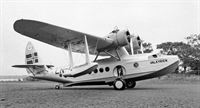Фотографии
-
Регистрационный номер: G-AEZE, LN-DAG [7] Looking considerably more modern than its contemporary, Valkyrien shares parking space with UK airline International Air Freight’s Curtiss Condor G-AEZE at Amsterdam, where the S-43 was overhauled by Dutch airline KLM before being delivered to French shipping company Compagnie des Chargeurs Reunis in 1937.
Самолёты на фотографии: Curtiss Condor 18 - США - 1929Sikorsky S-43 Baby Clipper/JRS/Y1OA-8 - США - 1936
-
Регистрационный номер: LN-DAE DNL operations began in June 1935 with chartered Junkers Ju 52/3m floatplane LN-DAE, named Havorn. It was originally suggested that this aircraft, fitted with additional fuel tanks, could be used to fly the North Atlantic trial service from Bergen to Reykjavik. In the event, DNL purchased a single Sikorsky S-43 instead. Havorn was lost when it flew into a mountain near Hyllestad in June the following year.
Самолёты на фотографии: Junkers Ju.52/3mW (See) - Германия - 1933
-
Регистрационный номер: LN-DAG [7] The colour scheme used for Valkyrien was simple but attractive, the upper fuselage retaining a natural-metal finish while the lower fuselage, hull, undersurfaces of the floats and engine nacelles were painted in a medium green. The fin sported the Norwegian flag below DNL’s logo.
Самолёты на фотографии: Sikorsky S-43 Baby Clipper/JRS/Y1OA-8 - США - 1936
-
Регистрационный номер: F-AQHY One of several S-43 amphibians operated by Compagnie des Chargeurs Reunis, which formed its own airline, Aeromaritime, in the early 1930s, to operate scheduled services along the West African coast, from Dakar in Senegal to Pointe Noire in French Equatorial Africa (now the Republic of Congo).
Самолёты на фотографии: Sikorsky S-43 Baby Clipper/JRS/Y1OA-8 - США - 1936
-
Регистрационный номер: NC16927 The Norwegian airline expected to be allocated an S-43 from the PAA order (one of which, twin-finned S-43B NC16927, is seen "on the step").
Самолёты на фотографии: Sikorsky S-43 Baby Clipper/JRS/Y1OA-8 - США - 1936
-
The prototype S-43 under construction at the Sikorsky factory at Bridgeport, Connecticut. The single biggest operator of the type was PAA and its Pacific and Latin American affiliates, which found the type eminently suitable for their needs.
Самолёты на фотографии: Sikorsky S-43 Baby Clipper/JRS/Y1OA-8 - США - 1936
-
Регистрационный номер: LN-DAG [7] Following the cancellation of the trans-atlantic trial flights in the summer of 1936, Valkyrien was used for a month on DNL’s Oslo-Stockholm service, and is seen here moored at the jetty at Gressholmen. Despite the advantages of operating a type that could take off from Bromma’s concrete runway and land on water at Oslo, DNL’s directors showed little enthusiasm for it.
Самолёты на фотографии: Sikorsky S-43 Baby Clipper/JRS/Y1OA-8 - США - 1936
-
Регистрационный номер: LN-DAG [7] Sikorsky S-43 amphibian LN-DAG, named Valkyrien, flies over Beerum, south of Oslo, during the aircraft’s short tenure with DNL during 1936-38. The "Baby Clipper", as the type was known, first flew in 1935 and in April 1936 set a world altitude record for amphibious aircraft when pilot Boris Sergievsky and designer Igor Sikorsky reached 27,950ft (8,520m) during a flight from Stamford, Connecticut.
Самолёты на фотографии: Sikorsky S-43 Baby Clipper/JRS/Y1OA-8 - США - 1936
-
Регистрационный номер: LN-DAG [7] Valkyrien bound for New York aboard a steamer in August 1936. On the far right is Bernt Balchen and second from the left is Chris Braathen, who did much of the liaison work between DNL and Sikorsky. Sadly he was killed in a crash in 1937.
Самолёты на фотографии: Sikorsky S-43 Baby Clipper/JRS/Y1OA-8 - США - 1936
-
Регистрационный номер: NC15061 The prototype of the attractive S-43, NC15061, during an early test flight. Three main variants were produced; the single-fin Pratt & Whitney Hornet-engined S-43A and a similarly-powered twin-finned version, the S-43B, which was usually delivered as a flying-boat and operated from water only. The final variant, the S-43W, was powered by Wright Cyclones.
Самолёты на фотографии: Sikorsky S-43 Baby Clipper/JRS/Y1OA-8 - США - 1936
-
Регистрационный номер: LN-DAG [7] The DNL S-43A on home soil at Gressholmen, the seaplane port at Oslo. Seating in the S-43 was usually arranged for three crew and 16 passengers, but a coach-style configuration could accommodate up to 25. Military variants were operated by the US Army Air Corps as the OA-8 and by the US Navy and Marine Corps as the JRS-1.
Самолёты на фотографии: Sikorsky S-43 Baby Clipper/JRS/Y1OA-8 - США - 1936
-
Регистрационный номер: LN-DAG [7] Valkyrien on its first flight over Oslo in 1936. Despite DNL’s misgivings about the type, based more on the financial burden it represented than its capabilities as an airliner, it proved popular with other operators in Hawaii, Alaska, Brazil, Chile, France, Russia and China.
Самолёты на фотографии: Sikorsky S-43 Baby Clipper/JRS/Y1OA-8 - США - 1936
-
A poor-quality image of DNL and PAA representatives during a meeting in Oslo in February 1937, including Hjalmar Riiser-Larsen (far left), Rudolf Olsen (second left) and Bernt Balchen (furthest right).
Самолёты на фотографии: Sikorsky S-43 Baby Clipper/JRS/Y1OA-8 - США - 1936
-
A rare DNL timetable for the summer of 1937, prominently featuring the airline’s most recent acquisition on the outer flap. The S-43 was little used, however, and, by the time this timetable was issued, considerable efforts were being made to find a new owner for it.
Самолёты на фотографии: Sikorsky S-43 Baby Clipper/JRS/Y1OA-8 - США - 1936
Статьи
- -
- A.Pelletier - Monsieur Moineau's Monstrosity
- B.Archer - Blackbird!
- B.Livingstone - The Jolly Rogers' Cape York catastrophe
- B.Turpin - Out on a Lympne (2)
- E.Wild - The graveyard shift
- J.Franzi - Nine's lives /An eye for detail/
- K.Hayward - Kill or cure? The view from Whitehall
- P.Davidson - Off the Beaten Track...
- P.Jarrett - Lost & Found
- P.Jarrett - The Hornet dilemma
- R.Flude - The Pacific Express
- R.Forsyth - Defending the Reich (3)
- R.Mulder - Pole position
- S.Rivas - Blue on blue













